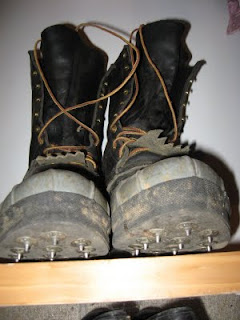It took years and some education to understand that this guy was just exhibiting classic evolutionary dynamics. Finding fertile ground in nouveau riche Dicksville (or Dix Hills, whatever), shoes had diversified like finches to occupy every niche, from the family's carpet showroom to various ritual contexts: Passover, Mall Cruising, trips to The City. Furthermore, through showy elaboration, his footwear had a demonstrated ability to signal to potential mates, "I have money, and I am not afraid to spend it on ridiculous crap." If I sound bitter, it's only because I find it sad when exotic species displace the indigenes that spent so many generations adapting to a place, that a flood of Gucci knock-offs extirpated farmers' clodhoppers and fishermens' chest waders.
In time, my engineer and combat boots mutated, as selective pressures shifted from seeking punk rock mates to psychedelic quests, which required things like moccasins and a pair of romeos bedecorated with day-glo lizards and such. Man, am sorry I don't have photos of those to post.
In the absence of a trust fund, the struggle for survival meant that those died out before too awful long, replaced by two major branches: rubba slippas and work boots. The last post introduced these species, mostly in an island leeward ecosystem context, but here I'd like to get into the diversification that burst forth when the varied demands of the Pacific Northwest began to affect new generations of boots.
Ambulamuchimus affordii. Low-rise cheap boots have survived the migration. Flexible generalists like these are fairly adaptable, and can get by in a variety of environments.

Ambulamuchimus robusta. With their top-grain cattle hide, lug soles (nearly worn off now), higher tops and insulation, and all around more rugged construction, these specimens outlive several generations of A. affordii, and in fact I inherited these from my dad. In addition to that sentimental allure (of little intrinsic value in the survival of the species), these are of good enough quality that I take the time to oil them. Their framework is such that the worn soles can be replaced, rather than dooming them to oblivion. A triumph of longevity that more than makes up for the low reproductive rate.

Fossicker aquaticus. These exhibit adaptation to the cold nearshore waters of the Puget Sound watershed. Waterproof, insulated, and crucial to the intertidal surveys and stream-walks an archaeologist needs to do in the northwest.
Gwarus lumberjackii. And finally we arrive at the corks, or calks, or whatever you want to call the giant spiky boots favored by those who must traipse through mossy forests. These can stomp into oblivion those pansy combat boots I wore so long ago. They transform wet slippery blowdown into boreal highways, ice into sidewalks. Waterproof, impervious to cold, and quite fetching to boot.







No comments:
Post a Comment